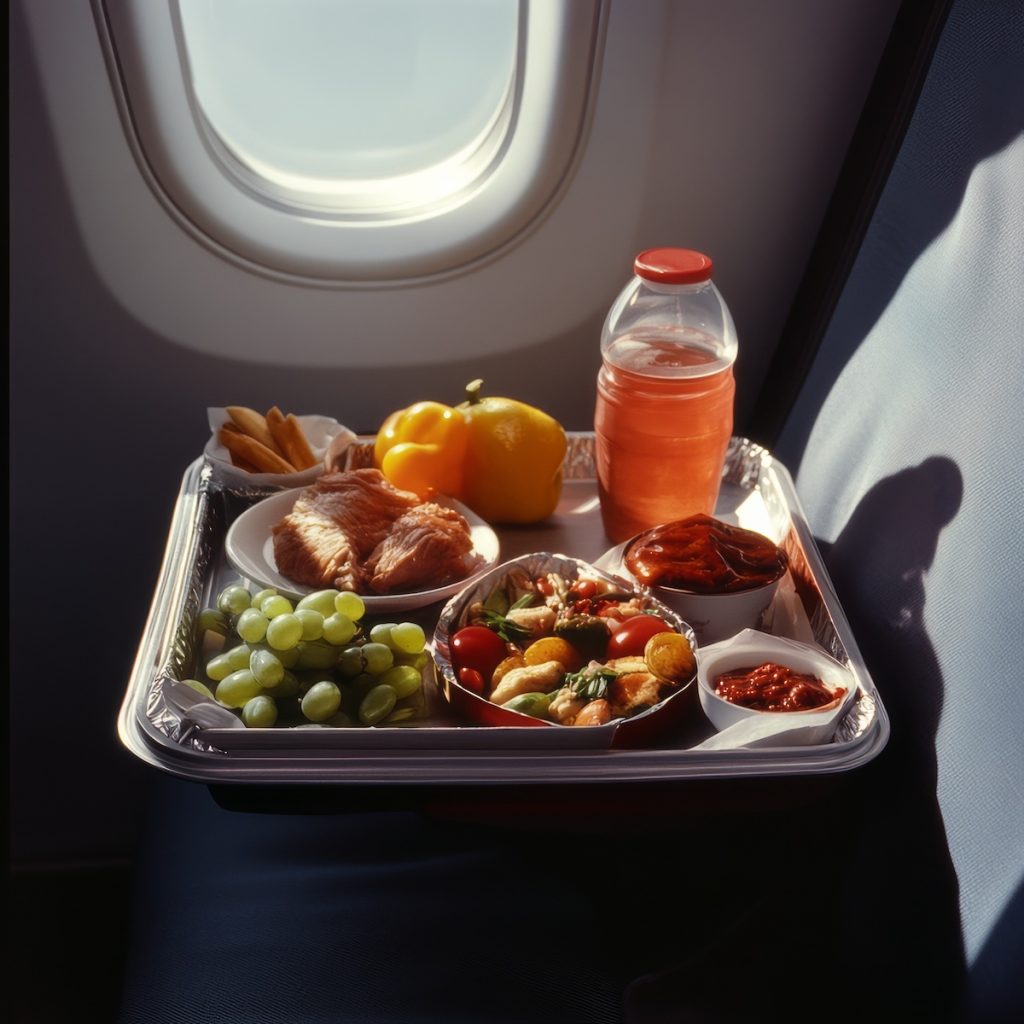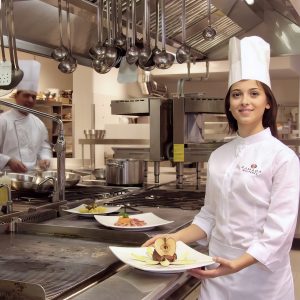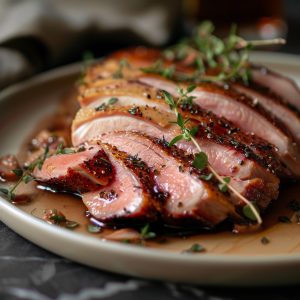The Journey of Airline Food: Planning, Preparing, and Serving at 30,000 Feet
Airline food production is a fascinating and complex process that ensures passengers enjoy a meal that meets high quality and safety standards, even while cruising thousands of feet above the ground. Behind the scenes, a sophisticated network of chefs, food scientists, and logistics experts work together to create, prepare, and deliver airline meals that are both nutritious and flavorful.
In this post, I’ll explore the intricate journey of airline food from conception to the cabin. We’ll delve into the meticulous planning involved in menu development, where chefs craft dishes that can withstand the unique conditions of air travel while still delivering on taste and presentation. We’ll also uncover the challenges of food storage and transportation and the rigorous safety standards that must be adhered to to ensure food quality and passenger health.
Additionally, we’ll look at the evolution of airline dining, from the early days of bland, mass-produced meals to today’s innovative and diverse offerings. Whether you’re curious about the logistics of airline catering or how your in-flight meal comes to be, this post will provide a comprehensive overview of the world of airline food production.
The journey of airline food from the initial concept to the cabin of an airplane involves several intricate steps, ensuring that meals meet high standards for quality, safety, and taste. Here’s a breakdown of the process:
- Menu Development: The process begins with culinary teams creating and refining menu options. Chefs work to design dishes that not only taste good but also hold up well during air travel. They consider factors like taste, texture, and nutritional balance while adhering to dietary restrictions and preferences.
- Tasting and Approval: After developing menu options, they undergo rigorous tasting sessions. Airline staff, including flight attendants and food experts, evaluate the meals for taste, presentation, and overall quality. Based on feedback, adjustments are made to ensure the meals will be well-received by passengers.
- Food Preparation: After approval, the meals are prepared in specialized airline catering kitchens. These facilities are equipped to handle large volumes of food while maintaining strict hygiene standards. Meals are cooked, assembled, and packaged in a way that preserves their quality during transit and reheating.
- Packaging and Storage: The meals are carefully packaged in containers designed to maintain temperature and prevent spoilage. They are then stored in refrigerated or frozen conditions until they are ready to be loaded onto the aircraft.
- Logistics and Transport: Meals are transported from the catering facilities to the airport. This involves coordination to ensure timely delivery and proper handling to maintain food safety standards.
- Onboard Service: The meals are loaded onto the aircraft once at the airport. During the flight, flight attendants reheat and serve the meals according to the airline’s service protocols, ensuring that passengers receive their food in the best possible condition.
- Feedback and Improvement: After the flight, passengers and crew receive feedback to evaluate the meals’ success. This feedback is used to improve future menu offerings and address any issues.
Through meticulous planning, preparation, and coordination, airlines strive to deliver meals that enhance the passenger experience, even at 30,000 feet.
Menu planning for airline food involves a multifaceted approach to ensure that meals are enjoyable and practical for in-flight service. Here’s what goes into the planning process:
- Passenger Preferences and Dietary Restrictions: Understanding and accommodating various dietary needs and preferences, including vegetarian, vegan, gluten-free, kosher, and halal options. Airlines often use passenger data and feedback to tailor menus to diverse tastes.
- Nutritional Balance: Creating balanced and nutritious meals, considering the limited options for fresh produce and the need for meals that provide energy and satisfaction during the flight.
- Culinary Appeal: Designing dishes that are flavorful and appealing while also able to withstand the unique conditions of air travel. Taste can be altered at high altitudes, so chefs often adjust recipes to ensure flavors remain robust.
- Packaging and Storage: Select foods that can be appropriately packaged to maintain quality, temperature, and safety. Packaging must be practical for storage and reheating onboard, and containers must prevent spillage and ensure ease of service.
- Preparation and Reheating: Developing recipes that can be prepped, cooked, and reheated efficiently without compromising taste or texture. Meals must be designed for optimal performance after being stored in refrigerated or frozen conditions.
- Logistics and Supply Chain: Coordinating with catering facilities to ensure that ingredients are available, hygiene standards are met, meals are prepared promptly, and everything is transported to the airport promptly.
- Regulatory Compliance: Adhering to food safety regulations and standards, including proper handling, storage, and preparation procedures to prevent contamination and ensure passenger safety.
- Cost Management involves balancing quality with budget constraints. Menu planning involves cost-effective ingredient sourcing while still aiming to deliver a satisfying dining experience.
- Seasonal and Regional Considerations: Incorporating seasonal ingredients and regional flavors to offer variety and freshness while managing supply chain logistics.
- Testing and Feedback: Conduct taste tests and gather feedback from passengers and airline staff to refine menu options and ensure high quality and satisfaction standards.
Effective menu planning for airline food requires careful consideration of these factors to deliver enjoyable, safe, and suitable meals for the unique air travel environment.
Entering the airline food production field combines culinary expertise, industry knowledge, and specialized skills. Here’s a step-by-step guide to getting into this field:
- Educational Background:
- Culinary Arts Degree: Obtain a culinary arts degree from a reputable institution. This provides a solid foundation in cooking techniques, food safety, and kitchen management.
- Food Science or Hospitality Management: Degrees in food science, food technology, or hospitality management can also be valuable, especially for roles in food production, quality control, or logistics.
- Gain Experience:
- Work in Culinary Settings: Gain experience in restaurants, hotels, or catering services. Experience in high-volume food production environments can be particularly beneficial.
- Internships and Entry-Level Positions: Look for internships or entry-level positions with catering companies or food service providers specializing in airline catering.
- Understand Airline Catering:
- Research the Industry: Familiarize yourself with the unique aspects of airline food production, including menu planning, food safety, and logistics.
- Networking: Connect with professionals in the airline catering industry through industry events, social media, and professional organizations.
- Specialize in Food Production and Logistics:
- Food Production Knowledge: Develop expertise in large-scale food production and packaging techniques. It is crucial to understand how to create meals that maintain quality during transport and storage.
- Logistics and Supply Chain: Gain knowledge of the logistics involved in food transportation, storage, and distribution, as these are key components of airline catering.
- Certifications and Training:
- Food Safety Certification: Obtain food safety and hygiene certifications, such as ServSafe or HACCP, which are essential in the food industry.
- Advanced Training: To enhance your qualifications, consider additional training or certifications related to airline catering or food science.
- Apply to Airline Catering Companies:
- Research Companies: Identify and apply to companies that provide airline catering services, such as LSG Sky Chefs, Gate Gourmet, or DO & CO.
- Tailor Your Resume: Highlight relevant experience, skills, and knowledge related to food production, safety, and logistics in your resume and cover letter.
- Stay Updated and Adapt:
- Industry Trends: Keep up with trends in airline food production, including new technologies, sustainability practices, and evolving passenger preferences.
- Continuous Learning: Engage in ongoing education and professional development to stay current.
Combining culinary skills with an understanding of the specific requirements of airline food production can help you build a successful career in this unique and dynamic field.
Several leading corporations specialize in providing food services for airlines, managing everything from meal preparation to logistics. Here are some of the top companies in the airline catering industry:
- LSG Sky Chefs: One of the largest and most prominent airline catering companies globally, LSG Sky Chefs provides various food services and solutions to airlines, including meal preparation and catering logistics.
- Gate Gourmet: A major player in the airline catering sector, Gate Gourmet offers catering services and food solutions for airlines worldwide, focusing on innovation and high-quality meal offerings.
- DO & CO: Known for its premium catering services, DO & CO provides gourmet meals and catering solutions to airlines and is recognized for its high-quality and diverse menu options.
- Flying Food Group: This company offers airline catering services, focusing on high-quality meal production, logistics, and food safety. It serves various airlines across the United States.
- ZRH Catering: Operating primarily in Switzerland and surrounding regions, ZRH Catering provides various airline catering services, focusing on quality and efficiency.
- Caterlink: Providing catering services primarily in the UK, Caterlink focuses on high-quality food solutions for airlines, including both onboard and ground services.
- Royal Catering: Serving airlines and other sectors, Royal Catering is known for its extensive experience providing high-quality meal services and logistics.
- Cuisine Solutions: Specializing in sous-vide cooking, Cuisine Solutions offers gourmet meal solutions and catering services for airlines, focusing on innovation and flavor.
These companies are key players in the airline catering industry, delivering meals and services that meet passengers’ diverse needs and expectations worldwide.












